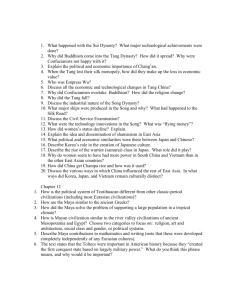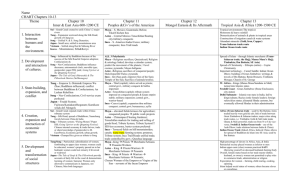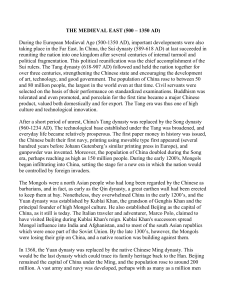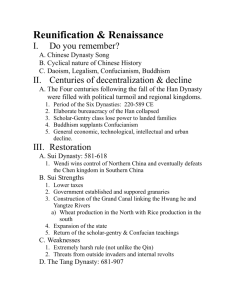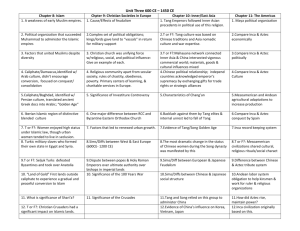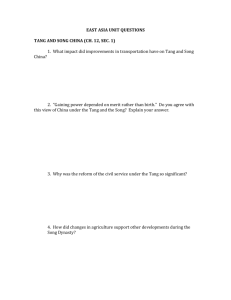A Review of Quarter 2 World History
advertisement
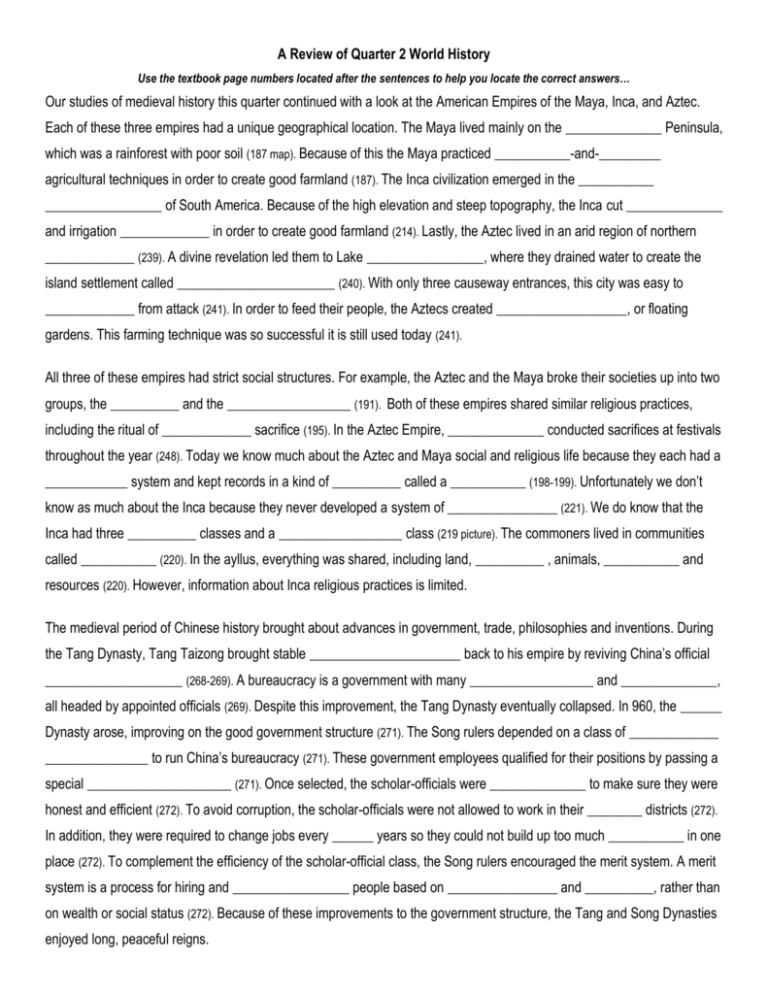
A Review of Quarter 2 World History Use the textbook page numbers located after the sentences to help you locate the correct answers… Our studies of medieval history this quarter continued with a look at the American Empires of the Maya, Inca, and Aztec. Each of these three empires had a unique geographical location. The Maya lived mainly on the ______________ Peninsula, which was a rainforest with poor soil (187 map). Because of this the Maya practiced ___________-and-_________ agricultural techniques in order to create good farmland (187). The Inca civilization emerged in the ___________ _________________ of South America. Because of the high elevation and steep topography, the Inca cut ______________ and irrigation _____________ in order to create good farmland (214). Lastly, the Aztec lived in an arid region of northern _____________ (239). A divine revelation led them to Lake _________________, where they drained water to create the island settlement called _______________________ (240). With only three causeway entrances, this city was easy to _____________ from attack (241). In order to feed their people, the Aztecs created ___________________, or floating gardens. This farming technique was so successful it is still used today (241). All three of these empires had strict social structures. For example, the Aztec and the Maya broke their societies up into two groups, the __________ and the __________________ (191). Both of these empires shared similar religious practices, including the ritual of _____________ sacrifice (195). In the Aztec Empire, ______________ conducted sacrifices at festivals throughout the year (248). Today we know much about the Aztec and Maya social and religious life because they each had a ____________ system and kept records in a kind of __________ called a ___________ (198-199). Unfortunately we don’t know as much about the Inca because they never developed a system of ________________ (221). We do know that the Inca had three __________ classes and a __________________ class (219 picture). The commoners lived in communities called ___________ (220). In the ayllus, everything was shared, including land, __________ , animals, ___________ and resources (220). However, information about Inca religious practices is limited. The medieval period of Chinese history brought about advances in government, trade, philosophies and inventions. During the Tang Dynasty, Tang Taizong brought stable ______________________ back to his empire by reviving China’s official ____________________ (268-269). A bureaucracy is a government with many __________________ and ______________, all headed by appointed officials (269). Despite this improvement, the Tang Dynasty eventually collapsed. In 960, the ______ Dynasty arose, improving on the good government structure (271). The Song rulers depended on a class of _____________ _______________ to run China’s bureaucracy (271). These government employees qualified for their positions by passing a special _____________________ (271). Once selected, the scholar-officials were ______________ to make sure they were honest and efficient (272). To avoid corruption, the scholar-officials were not allowed to work in their ________ districts (272). In addition, they were required to change jobs every ______ years so they could not build up too much ___________ in one place (272). To complement the efficiency of the scholar-official class, the Song rulers encouraged the merit system. A merit system is a process for hiring and _________________ people based on ________________ and __________, rather than on wealth or social status (272). Because of these improvements to the government structure, the Tang and Song Dynasties enjoyed long, peaceful reigns. During the medieval era in Chinese history, trade flourished. Massive cities like Chang’an were thriving ______________ and ____________________ centers (270). People from all over Asia, including Turks, Indians, ______________, Koreans, and ________ came to load their camels with goods (270). One factor that helped the growth in trade was the development of paper money. During the _________ period, the government issued the world’s first ___________ currency (285). This money was light in weight and easy to carry over long ____________________ (285). Traders traveled these long distances along the _________ Road to return home (270). In addition to goods, new philosophies made their way to China thanks to the Silk Road. ______________________, a religion based on the teachings of the Indian spiritual leader Siddhartha Gautama made its way north from the country of __________ (276). During the Tang Dynasty, Buddhism had ___________ of followers in China (277). Its appeal was based on the _________ for salvation and an end to ___________________ (276). While Buddhism was criticized for being an ___________ , or foreign, religion, Confucianism enjoyed a revival of strength during the middle ages (277). Confucianism was based on respect for the social __________ , respect for social _________, and the importance of ____________________ (278 chart). Children were taught that they should ___________ their parents and subjects were expected to respect their _____________ (278). In addition, Confucius taught that people could ____________ themselves through _____________________ , which supported the idea of the merit system during the Song Dynasty (278). However, because of the growing popularity of Buddhism, Confucian scholars created a revived form of Confucian thought influenced by _______________________ and _______________ (278). This new philosophy was called _______-Confucianism (278). The ideas of Neo-Confucianism had a great influence on China from the Song period onward. In addition to improving the government system and incorporating new philosophies into their society, the Chinese also created many useful inventions that have had a great impact on China and the rest of the world. The Chinese invented paper and by the 900s, ____________ had replaced papyrus across much of Asia (307). In addition, the moveable type printing process made writing and publishing easier. These two inventions made lowered the _________ of books and expanded the number of _____________ and, as a result, more people could learn to _________ and get an _________________ (282 & 308). The Chinese also discovered the ____________________ compound we know today as gunpowder (282). While the Chinese first used gunpowder to make ____________________ , this invention led to the creation of bombs, _____________ and other weapons during the Song era and beyond, becoming one of the most influential Chinese achievements that the world has ever known (282). Another key invention was the __________________ compass (282). In an age of travel and trade, this compass allowed sailors to sail to distant lands without getting _________ (282). However, despite having the magnetic compass, the Mongol ships, of the Yuan dynasty, sent to attack and invade Japan were met, without warning, by a _______________ , which destroyed their ships and ended the possibility of conquering Japan (339). The Japanese thought this rescue was a _____________________. They believed that the gods—the kami—had sent divine winds—_________________________—to help (340). From the beginning of their history, the Japanese believed that they were a people protected by the gods. However, in order to strengthen their culture, they borrowed heavily from the nearby countries of __________ and ___________ (327 map). Around the year 500A.D., the Japanese began to borrow the Chinese _______________ system (322). At first they used the Chinese ________________ , but eventually they began to write their own __________________ using Chinese characters (323). In addition to this, the Japanese leader, Prince Shotoku, sent official __________________________ to ___________ to study Chinese arts and ______________________ (327). These experts helped make Japan’s government move like that of _________________ _________ (327). From China, through the country of ___________ , came the religion, ________________ (327 map). This religion also had an influence on the Japanese government. The Constitution of ____________________ Articles called for ________________ for Buddhism (326). Despite drawing much influence from China and Korea, the Japanese had a social structure and a cultural life that was uniquely theirs. The social structure of Japanese society included many levels. The _________________ was at the top and he was responsible for granting the title of Shogun to the _____________ of the imperial __________ (332). The Shogun was the supreme _________________ commander and was supposed to rule Japan in the name of the emperor (332). In order to keep control over an often lawless and violent society, the _____________ , or land-owning lords, were charged with the responsibility of ____________________ the people (333). They did this by creating a new social order known as ____________________ (333). The Daimyo lords would grant people ________ or other rewards in exchange for military _____________ (333). This military service was provided by a small army of ____________ (333). The samurai would fight in exchange for land or ___________ (333). Because they lived under the code of _______________ , these samurai were loyal to their Daimyo lord, even above their own ___________ (338). An example of this loyalty can be found in “A Tale of Mutsu,” in which a samurai stated, “For thirty years now I have been in Yoriyoshi’s service…If he must ______ , I intend to share his fate and go with him to the underworld.” (338) Lastly, at the bottom of the social structure were the peasants, __________________ and artisans (332 picture). Art and culture in the medieval period was uniquely Japanese. Literature about Japanese court life was popular, and the world’s first ___________ , The Tale of Genji, was so impressive that today, readers are still __________________ by the descriptions of life at the Heian court (351). Short _________ were another popular form of literature (352). The Japanese invented the ___________ , a form of poetry with 17 syllables and three lines (352). These poems were used to create a quick and sometimes ____________________ image (352). To complement written forms of art, painting Heian artists developed a distinctively Japanese style of __________ painting known as Yamato-e (353). Each scroll told a story with pictures and depicted _________________ events, scenes from ___________ , and ______________ (353). Lastly, a new form of drama known as _______ appeared in Japan (355). These plays were serious and intense, performed on an almost ________ ___________ (355). However, the characters of the plays: __________ , warriors, beautiful women, crazy people, or ___________ and devils, were played by actors who wore ________________ _______________ robes and emotional ____________ on their faces (354-355).


